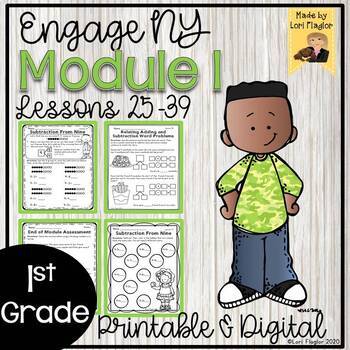Engage NY Grade 1 Module 1 Lessons 25-39 Printable and Digital Resource
- PDF
- Easel Activity
What educators are saying
Also included in
- If you are currently using the Engage NY Math Modules for 1st Grade then you must have this resource! These printable pages are a game changer for this program! Pages are ready to Print N Go or use Digitally with Google Slides or TPT Digital Overlay also known as the new Easel all in a kid friendlyPrice $63.00Original Price $78.50Save $15.50
Description
This resource is a must have if you are using the Engage NY Grade 1 math program. This is a 70+ page printable and digital resource for Module 1 Lessons 25-39. It focuses on Sums and Differences to 10. There are 4 pages per lesson perfect to review or teach key concepts, homework, distance learning, AIS math, or small group instruction all in a kid friendly format. Most lessons include a "teaching" page which explains the key concept for the lesson. The teaching page is perfect for distance learning! Also included is an End of Module Assessment.
Click HERE for a FREE SAMPLE for Module 1 Lesson 1-24.
**This resource has 2 digital versions available.**
1. You can access the TPT Digital Overlay which is located underneath the printable download. This version contains answer boxes and you can assign it directly to your Google Classroom.
2. This resource also contains a link in the printable version to download in Google Slides. You can add text boxes and directions to fit your specific needs.
Click HERE for a link to learn how to use the new TPT digital overlay version.
* Helpful hints on using the digital version is included in the printable version.
TEACHERS LIKE YOU SAID...
⭐️⭐️⭐️⭐️⭐️Dewitt's Doodlebugs said, "I am hooked! I love this resource and will be looking at getting other modules....use for homework in lieu of the Eureka program. Works so much better!"
⭐️⭐️⭐️⭐️⭐️Jayne M. said, "The students and I really enjoyed using the student friendly worksheets in teaching first grade concepts. Thank you for the dedication to helping teachers use child friendly materials to teach hard concepts for young children."
⭐️⭐️⭐️⭐️⭐️Sunshine and Broccoli said, "Love these! The worksheets are so much more visually appealing/clear for my kids. For distance learning last year I loved the teaching notes at the top of each lesson!"
⭐️⭐️⭐️⭐️⭐️Lexy T. said, "This has made teaching Eureka so much easier! I use part of the pages for homework and part for in-class problems sets! Love it! Very cute and user friendly!"
Don't use Engage NY? This resource is Common Core Aligned to first grade standards.
Concepts Included:
- Relating Add. and Subt. Word Problems
- Counting On to Find the Unknown Part
- Solve Take From with Result Unknown Word Stories
- Take Apart with Addend Unknown Word Stories
- Solve Add to with Change Unknown Word Stories
- Solve Take From with Change Unknown Word Stories
- Solve Put Together/Take Apart with Addend Unknown Word Stories
- Model 0 Less and One Less
- Model n-n and n-(n-1) as Subtraction Sentences
- Relate Subtraction Facts Using Fives and Doubles
- Subtraction from Ten
- Subtraction from Nine
- Using the Addition Chart to Solve Subtraction Problems
You may also like:
Grade 1 Module 1 Resources
Engage NY Grade 1 Module 1 FREE SAMPLE
Engage NY Grade 1 Module 1 Lessons 1-24 Printable and Digital Resource
Engage NY Grade 1 Module 1 Interactive Powerpoint Game
Grade 1 Module 2 Resources
Engage NY Grade 1 Module 2 Printable and Digital Resource
Engage NY Grade 1 Module 2 Interactive Powerpoint Game
Grade 1 Module 3 Resources
Engage NY Grade 1 Module 3 Printable and Digital Resource
Engage NY Grade 1 Module 3 Interactive Powerpoint Game
Grade 1 Module 4 Resources
Engage NY Grade 1 Module 4 Printable and Digital Resource
Engage NY Grade 1 Module 4 Interactive Powerpoint Game
Engage NY Grade 1 Module 4 Digital Task Cards
Grade 1 Module 5 Resources
Engage NY Grade 1 Module 5 Printable and Digital Resource
Engage NY Grade 1 Module 5 Interactive Powerpoint Game
Grade 1 Module 6 Resources
Engage NY Grade 1 Module 6 Printable and Digital Resource
Please consider following my store, new resources are 50% off for 48 hours. **







